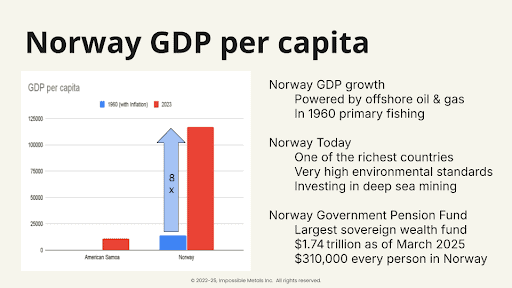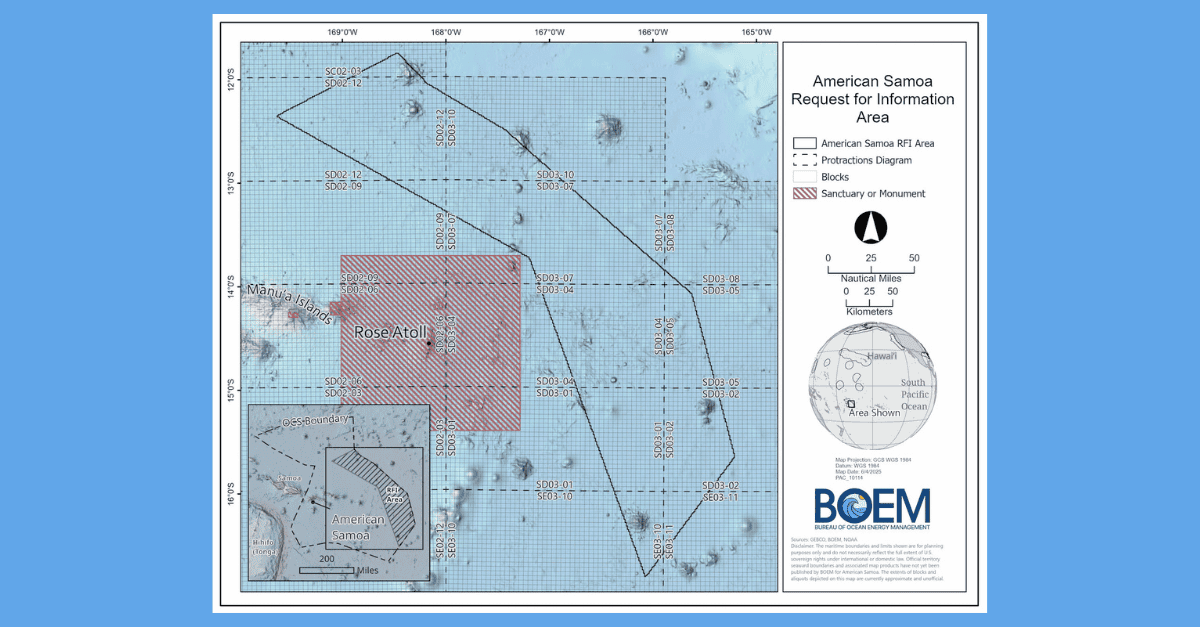America is stepping forward in the global race to secure critical minerals for clean energy and national security. At Impossible Metals, we are proving that seabed mining can be conducted responsibly, sustainably, and in partnership with local communities. Earlier this year, we became the first company to apply for a deep-sea critical mineral lease in U.S. federal waters, 130 miles off the coast of American Samoa.
As we pioneer innovation on the Outer Continental Shelf, it’s time for Congress to modernize our laws to ensure those most directly connected—the people of adjacent coastal states and territories—share in the benefits. Just as ocean energy has evolved, so too must our revenue-sharing model.
Should we be selected for the lease, Impossible Metals has committed to sharing a portion of our profits from marine mineral collection with American Samoa. Still, these communities’ return from marine mineral extraction should not simply be at the discretion of lessees — a portion of federal royalties should be shared with coastal communities, just as has been successfully done for decades with offshore oil and gas in the Gulf of America.
Coastal States and Territories Should Benefit from Offshore Leasing
When offshore lease sales occur—whether for oil, wind, or minerals—coastal communities are the most involved. They often experience new demands on infrastructure, take responsibility for environmental stewardship, and provide the workforce that operates and maintains the industry’s vessels. Yet, under current law, these coastal populations receive little to no financial compensation unless the project lies within three nautical miles of the shore.
That dynamic changed for Gulf Coast states with the passage of the “Gulf of Mexico Energy Security Act (GOMESA) of 2006.” GOMESA directs 37.5% of qualified Outer Continental Shelf revenues paid to the federal government placed into a special account. From that account, funds are disbursed to Gulf producing states (Alabama, Louisiana, Mississippi, and Texas) and their coastal political subdivisions. This structure essentially functions like a trust fund for coastal resilience, guaranteeing that a portion of the revenues from offshore development flow back into the regions most closely tied to them.
The results have been tangible: strengthening hurricane protection systems in Louisiana, restoring barrier islands in Mississippi, improving state parks and shorelines in Alabama, and funding coastal restoration and beach nourishment programs in Texas.
This framework has advanced coastal resilience and built public trust in offshore industry activities. We should replicate that success for marine minerals.
Modernizing Offshore Leases by Including Marine Minerals in the RISEE Act
Leaders in Congress have noted the disparity in providing revenue sharing for offshore oil and gas leases in the Gulf, but not for offshore wind projects, and have introduced the Reinvesting in Shoreline Economies and Ecosystems (RISEE) Act in response. The bipartisan RISEE Act, led by Senators Cassidy and Whitehouse in the Senate and Representatives Weber and Fletcher in the House, would apply the same revenue share system, dedicating 37.5% of the revenue to adjacent states for offshore wind leases more than 3 miles from the coast. The bill has 26 Senate and 47 House cosponsors, and it cleared its Senate committee unanimously last year, but it has not yet been reintroduced in 2025.
When Congress considers this bill again, it should also apply the same revenue-sharing principle to seabed minerals. This would ensure coastal states & territories receive a meaningful share of royalties from seabed mineral operations adjacent to their shorelines, supporting conservation, infrastructure, environmental monitoring, and community resilience projects. It would also make state and territorial governments partners in the first modern leases for deep sea minerals.
Norway: A Model for Transformational Growth
History shows how transformative offshore resource development can be for societies. In 1960, almost no one worked in offshore oil and gas. According to a report by the International Energy Agency (IEA), the global oil and gas sector employed 11.8 million people in 2019, with nearly one-third of these employees working in offshore operations. Another 60 million people work in its supply chain.
Norway provides perhaps the clearest example. Once a fishing nation with a GDP per capita comparable to that of American Samoa today, Norway is now one of the wealthiest countries in the world, thanks to offshore oil and gas. Its GDP per capita has grown eightfold since 1960, and its Government Pension Fund—the world’s largest sovereign wealth fund—now exceeds $1.7 trillion, equivalent to about $310,000 for every Norwegian citizen. Crucially, Norway invested offshore revenues back into the people, building both prosperity and high environmental standards.
That same playbook can guide the United States: harnessing seabed mineral resources while investing revenues back into coastal communities and resilience.

Benefits Beyond Dollars
Revenue sharing is about more than money—it is about aligning incentives so that coastal states see themselves as true partners, not reluctant stakeholders. When states share in revenues, they are motivated to support responsible development and invest in the resilience of their communities. Channeling revenues into coastal resilience programs turns today’s challenges—sea-level rise, storms, and erosion—into opportunities for stronger, safer communities.
Congress should update the Outer Continental Shelf Lands Act to extend GOMESA-style revenue sharing to marine minerals, ensuring that America’s coastal communities benefit as we responsibly unlock the resources needed for a secure, clean-energy future.
